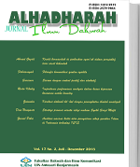Pemanfaatan Dimensi Siber Media dalam Membentuk Citra Keagamaan Selebriti Qari’ di TikTok
DOI:
https://doi.org/10.18592/alhadharah.v23i1.12236Keywords:
cyber media, micro celebrity, reciter, religious imageAbstract
This article explores how social media, particularly TikTok, shapes the religious image of Qari' celebrities. It aims to elucidate the process of producing Al-Quran recitations by micro-celebrity ustaz on social media, understand the content and meaning of these recitations, investigate user interactions and responses, and explore the motives behind sharing these recitations. The study uses qualitative methods, focusing on TikTok accounts @ustadzdaeng and @niichaan15. Findings indicate that Al-Quran recitations on social media create immersive experiences for followers and extend the reach of religious messages. The motives for producing these recitations include digital da'wah, promoting religious values, and building a positive image. This article provides insights into the production and impact of Al-Quran recitations by celebrity reciters on social media, highlighting the role of social media in shaping positive religious portrayals.References
Anam, Khoirul. 2024. “Strategi Dakwah Efektif di Era Kekinian.” Fahmuna: Jurnal Dakwah dan Komunikasi 1 (1): 56–62.
Berger, Peter L., and Thomas Luckmann. 2012. Tafsir Sosial Atas Kenyataan: Risalah Tentang Sosiologi Pengetahuan. Edited by Imam Ahmad and Tika Noorjaya. Jakarta: LP3ES.
Berger, Peter L., and Thomas Luckmann. 1991. The Social Construction of Reality: A Treatise in the Sociology of Knowledge. USA: Penguin Books.
Bungin, Burhan Konstruksi Sosial Media Massa. 2006. Sosiologi Komunikasi, Teori, Paradigma, Dan Diskursus Teknologi Komunikasi Di Masyarakat. Jakarta: Kencana.
Ema, Ema, and Luluatu Nayiroh. 2024. “Komunikasi Media Sosial Sebagai Alat Mobilisasi Gerakan Sosial Di Indonesia.” Jurnal Ilmu Komunikasi UHO : Jurnal Penelitian Kajian Ilmu Komunikasi Dan Informasi 9 (1): 221–38. https://doi.org/10.52423/jikuho.v9i1.159.
exolyt.com. 2024a. “Anisanurles Overview.” January 2024. https://doi.org/10.5614/sostek.itbj.2018.17.2.9.
———. 2024b. “Ustadzdaeng Overview.” January 2024. https://doi.org/10.5614/sostek.itbj.2018.17.2.9.
Iryani, Juniarti, and Nurwahid Syam. 2023. “Peran Media Sosial Dalam Menyebarkan Pesan Agama Dan Perubahan Sosial.” PUSAKA 11 (2): 359–72. https://doi.org/10.31969/pusaka.v11i2.1242.
Jannah, Imas Lu’ul. 2020. “Qari Selebriti: Resitasi Al-Qur’an Dan Anak Muda Muslim Indonesia Di Era Media Sosial.” In Program Studi Interdisciplinary Islamic Studies Konsentrasi Hermeneutika Alquran. UIN Sunan Kalijaga.
Juditha, Christiany, and Josep J. Darmawan. 2022. “Tiktok’s Stitch Trends As A Feature Of Citizens’ Negation In Communication On Social Media.” Jurnal Komunikasi 15 (2): 242–58. https://doi.org/10.24912/jk.v15i2.23323.
Kawasaki, Guy, and Peg Fitzpatrick. 2014. The Art of Social Media: Power Tips for Power Users. UK: Penguin Press.
Latifah, Ultria, and Almira Mutiara Imanda. 2022. “Analisis Strategi Impression Management Dalam Membentuk Personal Branding Selebgram Melalui Instagram.” Jurnal Pendidikan Tambusai 6 (2): 15765–77. https://doi.org/10.31004/jptam.v6i2.4880.
Marwick, Alice, and Danah Boyd. 2011. “To See and Be Seen: Celebrity Practice on Twitter.” Convergence: The International Journal of Research into New Media Technologies 17 (2): 139–58. https://doi.org/10.1177/1354856510394539.
Marwick, Alice E., Diego M. Diaz, and J. Palfrey. 2010. Youth, Privacy and Reputation. Cambridge: The Berkman Center for Internet & Society.
Masrurin, ‘Ainatu. 2019. “Murattal Dan Mujawwad Al-Qur’an Di Media Sosial.” Jurnal Studi Ilmu- Ilmu Al-Qur’an Dan Hadis 19, no. 2, 188.
Nasrullah, Rulli. 2017. Teori Dan Riset Media Siber (Cybermedia). Vol. 7. Jakarta: Prenada Media Group.
Salman, Dio Herman Saputra, and Raka Wisnu Wardana. 2019. “Media Sosial dan Masyarakat Baru di Post Truth Era.” Kalbisocio: Jurnal Bisnis dan Komunikasi 6 (2): 136–40.
Sangadji, Fadhila Amalia Putri, Amelia Cahya Syah Fitri, Della Anzelia Sitanggang, Rusdi Hidayat, and Maharani Ikaningtyas. 2024. “Peran Media Sosial Tiktok Sebagai Platform Untuk Pengembangan Bisnis Di Era Digital.” KARYA: Jurnal Pengabdian Kepada Masyarakat 4 (1): 143–49.
Senft, Theresa M. 2008. Camgirls: Celebrity and Community in the Age of Social Networks. New York: Peter Lang.
Stringer, Ebonie Cunningham. 2009. “‘Keeping the Faith’: How Incarcerated African American Mothers Use Religion and Spirituality to Cope with Imprisonment.” Journal of African American Studies 13 (3): 325–47. https://doi.org/10.1007/S12111-009-.
Suci, LR, and Haris Suprapto. 2022. “Konstruksi Realitas Sosial Dalam Novel Orang-Orang Oetimu Karya Felix K. Nesi: Kajian Konstruksi Sosial Peter L. Berger Dan Thomas Luckmann.” BAPALA 9 (3). https://ejournal.unesa.ac.id.
Tamrin, Tamrin. 2015. “Perluasan Makna Kata Sapaan Daeng Dalam Bahasa Makassar.” Sirok Bastra 3 (1): 45–52. https://doi.org/10.37671/sb.v3i1.53.
Turner, Graeme. 2010. Ordinary Poeple and the Media: Teh Domotic Turn. India, New Delhi: Sage.
Wibisono, M. Yusuf, and Wahyudin Darmalaksana. 2022. “The Idea of Moderate Islam in the Media Space for the Social Construction of Religious Moderation in Indonesia.” Khazanah Sosial 4 (4): 719–30. https://doi.org/10.15575/ks.v4i4.19291.
Downloads
Published
How to Cite
Issue
Section
License
Copyright (c) 2024 Wahab Kadri, Achmad Fachruddin, Marini

This work is licensed under a Creative Commons Attribution-NonCommercial 4.0 International License.
Authors retain copyright and grant the journal the right of first publication, with the work simultaneously licensed under the Creative Commons Attribution-NonCommercial 4.0 International Public License (CC BY-NC 4.0). This license allows reusers to distribute, remix, adapt, and build upon the material in any medium or format for noncommercial purposes only, provided that proper attribution is given to the original creator.







